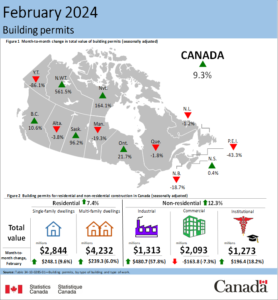
Canada posts permit gains in February
By Adam Freill
Commercial Construction Industrial Institutional ResidentialThe values of building permits issued for all segments, aside from commercial, were on the rise in February.

Building permits, February 2024 (Source: Statistics Canada, Table 34-10-0285-01, Building permits, by type of building and type of work.)
Several major non-residential construction projects helped drive the value of building permits to $11.8 billion in February, a gain of 9.3 per cent from January. The non-residential sector grew 12.3 per cent, to $4.7 billion, while the residential sector increased 7.4 per cent, coming in at $7.1 billion. A gain of almost 22 per cent in Ontario led provinces in growth, with gains occurring across all components there.
Growth in the non-residential sector was mostly attributed to the industrial component, which rose 57.8 per cent to reach $1.3 billion in February. Permits for large industrial construction projects were issued across the country, including permits for the construction of a new battery plant in Windsor, Ont., a new dairy processing facility in Abbotsford, B.C., a new pea processing plant in Yorkton, Sask., and the expansion of an aluminum smelting facility in Saguenay, Que.
Also on the rise in the non-residential sector was the institutional component, which posted gains in excess of 18 per cent as it posted $1.3 billion in permits.
On the residential side, intentions for single-dwelling units rose almost 10 per cent, while multi-dwelling units posted a six per cent gain in permit values in February. Ontario, British Columbia, Quebec and Alberta were the primary contributors to the second consecutive monthly increase in the residential sector. Across Canada, 16,400 new dwellings in multi-unit buildings and 4,600 new single-family dwellings were authorized in February. From March 2023 to February 2024, a total of 253,400 new units were authorized.




